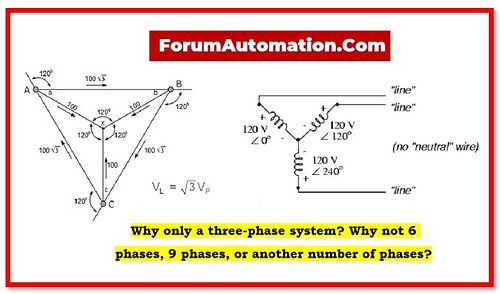Why 3-Phase? The possibility which frequently crosses an electrical professional’s consideration is “why not 6 or 9 Phase?” The three-phase system is used, but there are no particular reasons for doing so. 2, 3, 4, or 6 phases of an electrical system are possibilities.
The closest integer to Π (3.14) or the root of the natural logarithm system (2.781), according to certain electrical professionals, engineers, and scientists, is the number 3. and although this might be a problem, the three-phase system is not used.
The simple fact is that the initial generation of electric generators, developed near the latter part of the nineteenth century, had 3-phase loops in them. This is likely because three was considered to be an acceptable balance between two and three phases, which would leave a noticeable gap on either side of the generator, & six (or) more phases, which would lead to manufacturing complexity, which was a serious problem before the introduction of standardised parts and assembly line production.
Comparing the three-phase method to various numbers of phases, it proved to be quite efficient and manageable, therefore evolved since three phases proven to be a reasonable amount of efficient and manageable, it actually established a standard, & then the official one, and all power systems are standardised on three phases as of today.
Six-phase transmission lines, specialised generators, or equipment are utilised in some industrial processes requiring for nine, twelve, or even fifteen phases of power for esoteric particular reasons.
Thus, the power systems’ three phases are present only by design.
To understand why 3-Phase was chosen rather than 6- or 9-Phase, let’s explore it in more depth.
What Makes a 3-Phase System further economical?
A three-phase system is really more effective than a two-phase or three-phase system. Comparing a three-phase system to a single phase system, the copper loss is reduced by around 75%. Although the reduction is slight, the number of stages further reduces copper loss. The disadvantage of having more phases is that the number of conductor loads on the transmission towers must be increased. The overall cost of the electrical system increases as a result.
Why 3-Phase? Why not Phase 6 or Phase 9?
The power output of a three-phase system is three times that of a single phase. When compared to three phases, the power added by six phases is twice as much. However, 12 phases do not add power twice as much as 6 phases. As the number of phases increases, the power transfer curves exhibits a characteristic decrease. Additionally, greater phases would enclose the grid more. The equipment design for 6,9 or more phases is intricate and expensive.
Function of 3-phase
The fact that 3-phase motors & generators have consistent torque is one of the arguments for the advantages of using the three-phase system. As a result, it eliminates the possibility of oscillating torques that could damage the motor or generator. Despite having the advantage that a 6- or 9-phase system produces more constant torque than a three-phase system, the system gets incredibly complex as the number of phases increases. The simplest system that produces continuous motor/generator torque has the fewest phases—three.
In a three-phase system, the phase angle between the transmission lines voltage is 360/3=120 degrees.
The phase difference reduces with an increase in phases as the total number of phases increases. As is well known, line transposition occurs to lessen inductance inequality as well as inductive interference brought on by communication lines next to power lines. With additional stages, the transposition of the lines gets more challenging. The amount that it will cost to construct a transmission tower is also affected by this factor. As a result, a 3-phase system is more cost-effective than a 6- or 9-phase system.
Conclusion
Low-power applications are acceptable for the single-phase system. Three times as much power is generated by a three-phase system as compared to a single phase. A three-phase system is also more effective than a single phase. Therefore, for efficient generation, transmission, and utilisation, a 3-phase system is optimal.
